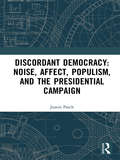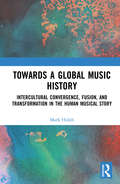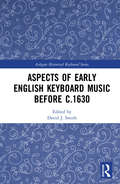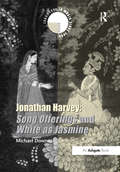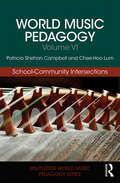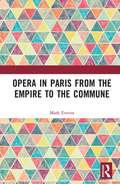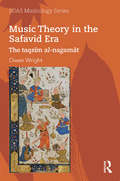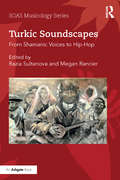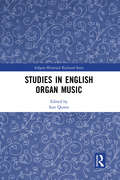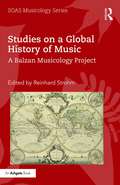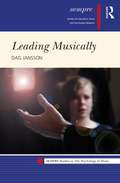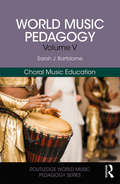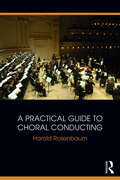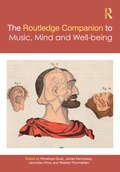- Table View
- List View
Discordant Democracy: Discordant Magic
by Justin PatchDiscordant Democracy: Noise, Affect, Populism, and the Presidential Campaign paints a portrait of the political experience at a pivotal time in American political and social history. The modern political campaign is aestheticized and assimilated into mass culture, divorced from fact and policy, and nakedly tethered to emotional appeal. Through a multi-modal comparative examination of the sonic and emotional cultures of the 2008 and 2016 campaigns, Justin Patch raises critical queries about our affective relationship to modern politics and the impact of emotional campaigning on democracy. Discordant Democracy asks: how do campaign sounds affect us; what role do we the electorate play in creating and sustaining these sounds and affects; and what actions do they generate? Theories from anthropology, cognitive science, sound studies and philosophy are engaged to grapple with these questions and connect bombastic mass-mediated political events, campaign media and individual sonic experience. The analyses complicate notions of top-down campaigning, political spin, and enthusiastic millennial populism by examining our role in producing and animating political sounds through conversation, applause, laughter, media, and music.
Towards a Global Music History: Intercultural Convergence, Fusion, and Transformation in the Human Musical Story
by Mark HijlehHow do we explain the globalized musical world in which we find ourselves in the early 21st century and how did we arrive here? This extraordinary book outlines an understanding of the human musical story as an intercultural—and ultimately a transcultural—one, with travel and trade as the primary conditions and catalysts for the ongoing development of musical styles. Starting with the cultural and civilizational precedents that gave rise to the first global trading and travel network in both directions across the Afro-Eurasian Old World Web in the form of the Silk Road, the book proceeds to the rise of al-Andalus and its influence on Europe through the Iberian peninsula before considering the fusion of European, African and indigenous musics that emerged in the Americas between c1500-1920 as part of Atlantic culture and the New World Web, as well as the concurrent acceleration of globalism in music through European empires and exoticism. The book concludes by examining the musical implications of our current Age of Instantaneous Exchange that technology permits, and by revisiting the question of interculturality and transculurality in music.
Towards a Global Music History: Intercultural Convergence, Fusion, and Transformation in the Human Musical Story
by Mark HijlehHow do we explain the globalized musical world in which we find ourselves in the early 21st century and how did we arrive here? This extraordinary book outlines an understanding of the human musical story as an intercultural—and ultimately a transcultural—one, with travel and trade as the primary conditions and catalysts for the ongoing development of musical styles. Starting with the cultural and civilizational precedents that gave rise to the first global trading and travel network in both directions across the Afro-Eurasian Old World Web in the form of the Silk Road, the book proceeds to the rise of al-Andalus and its influence on Europe through the Iberian peninsula before considering the fusion of European, African and indigenous musics that emerged in the Americas between c1500-1920 as part of Atlantic culture and the New World Web, as well as the concurrent acceleration of globalism in music through European empires and exoticism. The book concludes by examining the musical implications of our current Age of Instantaneous Exchange that technology permits, and by revisiting the question of interculturality and transculurality in music.
Aspects of Early English Keyboard Music before c.1630 (Ashgate Historical Keyboard Series)
by David J. SmithEnglish keyboard music reached an unsurpassed level of sophistication in the late sixteenth and early seventeenth centuries as organists such as William Byrd and his students took a genre associated with domestic, amateur performance and treated it as seriously as vocal music. This book draws together important research on the music, its sources and the instruments on which it was played. There are two chapters on instruments: John Koster on the use of harpsichord during the period, and Dominic Gwynn on the construction of Tudor-style organs based on the surviving evidence we have for them. This leads to a section devoted to organ performance practice in a liturgical context, in which John Harper discusses what the use of organs pitched in F may imply about their use in alternation with vocal polyphony, and Magnus Williamson explores improvisational practice in the Tudor period. The next section is on sources and repertoire, beginning with Frauke Jürgensen and Rachelle Taylor’s chapter on Clarifica me Pater settings, which grows naturally out of the consideration of improvisation in the previous chapter. The next two contributions focus on two of the most important individual manuscript sources: Tihomir Popović challenges assumptions about My Ladye Nevells Booke by reflecting on what the manuscript can tell us about aristocratic culture, and David J. Smith provides a detailed study of the famous Fitzwilliam Virginal Book. The discussion then broadens out into Pieter Dirksen’s consideration of a wider selection of sources relating to John Bull, which in turn connects closely to David Leadbetter’s work on Gibbons, lute sources and questions of style.
Aspects of Early English Keyboard Music before c.1630 (Ashgate Historical Keyboard Series)
by David J. SmithEnglish keyboard music reached an unsurpassed level of sophistication in the late sixteenth and early seventeenth centuries as organists such as William Byrd and his students took a genre associated with domestic, amateur performance and treated it as seriously as vocal music. This book draws together important research on the music, its sources and the instruments on which it was played. There are two chapters on instruments: John Koster on the use of harpsichord during the period, and Dominic Gwynn on the construction of Tudor-style organs based on the surviving evidence we have for them. This leads to a section devoted to organ performance practice in a liturgical context, in which John Harper discusses what the use of organs pitched in F may imply about their use in alternation with vocal polyphony, and Magnus Williamson explores improvisational practice in the Tudor period. The next section is on sources and repertoire, beginning with Frauke Jürgensen and Rachelle Taylor’s chapter on Clarifica me Pater settings, which grows naturally out of the consideration of improvisation in the previous chapter. The next two contributions focus on two of the most important individual manuscript sources: Tihomir Popović challenges assumptions about My Ladye Nevells Booke by reflecting on what the manuscript can tell us about aristocratic culture, and David J. Smith provides a detailed study of the famous Fitzwilliam Virginal Book. The discussion then broadens out into Pieter Dirksen’s consideration of a wider selection of sources relating to John Bull, which in turn connects closely to David Leadbetter’s work on Gibbons, lute sources and questions of style.
Jonathan Harvey: Song Offerings and White as Jasmine (Landmarks in Music Since 1950)
by Michael DownesJonathan Harvey (1939-2012) was one of Britain's leading composers: his music is frequently performed throughout Europe, the United States (where he lived and worked) and Japan. He is particularly renowned for his electro-acoustic music, an aspect on which most previous writing on his work has focused. The present volume is the first detailed study of music from Harvey's considerable body of work for conventional forces. It focuses on two pieces that span one of the most fertile periods in Harvey's output: Song Offerings (1985; awarded the prestigious Britten Award), and White as Jasmine (1999). The book explores the links between the two works - both set texts by Hindu writers, employ a solo soprano, and adumbrate a spiritual journey - as well as showing how Harvey's musical language has evolved in the period between them. It examines Harvey's techniques of writing for the voice, for small ensemble (Song Offerings), and for large orchestra, subtly and characteristically enhanced with electronic sound (White as Jasmine). It shows how Harvey's music is informed by his profound understanding of Eastern religion, as well as offering a clear and accessible account of his distinctive musical language. Both works use musical processes to dramatic and clearly audible effect, as the book demonstrates with close reference to the accompanying downloadable resources. The book draws on interviews with the composer, and benefits from the author's exclusive access to sketches of the two works. It contextualises the works, showing how they are the product of a diverse series of musical influences and an engagement with ideas from both Eastern and Western religions. It also explores how Harvey continued to develop the musical and spiritual preoccupations revealed in these pieces in his later work, up to and including his third opera, Wagner Dream (2007).
Jonathan Harvey: Song Offerings and White as Jasmine (Landmarks in Music Since 1950)
by Michael DownesJonathan Harvey (1939-2012) was one of Britain's leading composers: his music is frequently performed throughout Europe, the United States (where he lived and worked) and Japan. He is particularly renowned for his electro-acoustic music, an aspect on which most previous writing on his work has focused. The present volume is the first detailed study of music from Harvey's considerable body of work for conventional forces. It focuses on two pieces that span one of the most fertile periods in Harvey's output: Song Offerings (1985; awarded the prestigious Britten Award), and White as Jasmine (1999). The book explores the links between the two works - both set texts by Hindu writers, employ a solo soprano, and adumbrate a spiritual journey - as well as showing how Harvey's musical language has evolved in the period between them. It examines Harvey's techniques of writing for the voice, for small ensemble (Song Offerings), and for large orchestra, subtly and characteristically enhanced with electronic sound (White as Jasmine). It shows how Harvey's music is informed by his profound understanding of Eastern religion, as well as offering a clear and accessible account of his distinctive musical language. Both works use musical processes to dramatic and clearly audible effect, as the book demonstrates with close reference to the accompanying downloadable resources. The book draws on interviews with the composer, and benefits from the author's exclusive access to sketches of the two works. It contextualises the works, showing how they are the product of a diverse series of musical influences and an engagement with ideas from both Eastern and Western religions. It also explores how Harvey continued to develop the musical and spiritual preoccupations revealed in these pieces in his later work, up to and including his third opera, Wagner Dream (2007).
World Music Pedagogy, Volume VI: School-community Intersections (Routledge World Music Pedagogy Series)
by Patricia Shehan Campbell Chee Hoo LumWorld Music Pedagogy, Volume VI: School-Community Intersections provides students with a resource for delving into the meaning of "world music" across a broad array of community contexts and develops the multiple meanings of community relative to teaching and learning music of global and local cultures. It clarifies the critical need for teachers to work in tandem with community musicians and artists in order to bridge the unnecessary gulf that often separates school music from the music of the world beyond school and to consider the potential for genuine collaborations across this gulf. The five-layered features of World Music Pedagogy are specifically addressed in various school-community intersections, with attention to the collaboration of teachers with local community artist-musicians and with community musicians-at-a-distance who are available virtually. The authors acknowledge the multiple routes teachers are taking to enable and encourage music learning in community contexts, such as their work in after-school academies, museums and libraries, eldercare centers, places of worship, parks and recreation centers, and other venues in which adults and children gather to learn music, make music, and become convivial through music This volume suggests that the world’s musical cultures may be found locally, can be tapped virtually, and are important in considerations of music teaching and learning in schools and community contexts. Authors describe working artists and teachers, scenarios, vignettes, and teaching and learning experiences that happen in communities and that embrace the role of community musicians in schools, all of which will be presented with supporting theoretical frameworks.
World Music Pedagogy, Volume VI: School-Community Intersections (Routledge World Music Pedagogy Series)
by Patricia Shehan Campbell Chee Hoo LumWorld Music Pedagogy, Volume VI: School-Community Intersections provides students with a resource for delving into the meaning of "world music" across a broad array of community contexts and develops the multiple meanings of community relative to teaching and learning music of global and local cultures. It clarifies the critical need for teachers to work in tandem with community musicians and artists in order to bridge the unnecessary gulf that often separates school music from the music of the world beyond school and to consider the potential for genuine collaborations across this gulf. The five-layered features of World Music Pedagogy are specifically addressed in various school-community intersections, with attention to the collaboration of teachers with local community artist-musicians and with community musicians-at-a-distance who are available virtually. The authors acknowledge the multiple routes teachers are taking to enable and encourage music learning in community contexts, such as their work in after-school academies, museums and libraries, eldercare centers, places of worship, parks and recreation centers, and other venues in which adults and children gather to learn music, make music, and become convivial through music This volume suggests that the world’s musical cultures may be found locally, can be tapped virtually, and are important in considerations of music teaching and learning in schools and community contexts. Authors describe working artists and teachers, scenarios, vignettes, and teaching and learning experiences that happen in communities and that embrace the role of community musicians in schools, all of which will be presented with supporting theoretical frameworks.
Opera in Paris from the Empire to the Commune
by Mark EveristStudies in the history of French nineteenth-century stage music have blossomed in the last decade, encouraging a revision of the view of the primacy of Austro-German music during the period and rebalancing the scholarly field away from instrumental music (key to the Austro-German hegemony) and towards music for the stage. This change of emphasis is having an impact on the world of opera production, with new productions of works not heard since the nineteenth century taking their place in the modern repertory. This awakening of enthusiasm has come at something of a price. Selling French opera as little more than an important precursor to Verdi or Wagner has entailed a focus on works produced exclusively for the Paris Opéra at the expense of the vast range of other types of stage music produced in the capital: opéra comique, opérette, comédie-vaudeville and mélodrame, for example. The first part of this book therefore seeks to reintroduce a number of norms to the study of stage music in Paris: to re-establish contexts and conventions that still remain obscure. The second and third parts acknowledge Paris as an importer and exporter of opera, and its focus moves towards the music of its closest neighbours, the Italian-speaking states, and of its most problematic partners, the German-speaking states, especially the music of Weber and Wagner. Prefaced by an introduction that develops the volume’s overriding intellectual drivers of cultural exchange, genre and institution, this collection brings together twelve of the author’s previously published articles and essays, fully updated for this volume and translated into English for the first time.
Opera in Paris from the Empire to the Commune
by Mark EveristStudies in the history of French nineteenth-century stage music have blossomed in the last decade, encouraging a revision of the view of the primacy of Austro-German music during the period and rebalancing the scholarly field away from instrumental music (key to the Austro-German hegemony) and towards music for the stage. This change of emphasis is having an impact on the world of opera production, with new productions of works not heard since the nineteenth century taking their place in the modern repertory. This awakening of enthusiasm has come at something of a price. Selling French opera as little more than an important precursor to Verdi or Wagner has entailed a focus on works produced exclusively for the Paris Opéra at the expense of the vast range of other types of stage music produced in the capital: opéra comique, opérette, comédie-vaudeville and mélodrame, for example. The first part of this book therefore seeks to reintroduce a number of norms to the study of stage music in Paris: to re-establish contexts and conventions that still remain obscure. The second and third parts acknowledge Paris as an importer and exporter of opera, and its focus moves towards the music of its closest neighbours, the Italian-speaking states, and of its most problematic partners, the German-speaking states, especially the music of Weber and Wagner. Prefaced by an introduction that develops the volume’s overriding intellectual drivers of cultural exchange, genre and institution, this collection brings together twelve of the author’s previously published articles and essays, fully updated for this volume and translated into English for the first time.
Music Theory in the Safavid Era: The taqsīm al-naġamāt (SOAS Studies in Music Series)
by Owen WrightThe Safavid era (1501–1722) is one of the most important in the history of Persian culture, celebrated especially for its architecture and art, including miniature paintings that frequently represent singers and instrumentalists. Their presence reflects a sophisticated tradition of music making that was an integral part of court life, yet it is one that remains little known, for the musicological literature of the period is rather thin. There is, however, a significant exception: the text presented and analysed here, a hitherto unpublished and anonymous theoretical work probably of the middle of the sixteenth century. With a Sufi background inspiring the use of the nay as a tool of theoretical demonstration, it is exceptional in presenting descriptive accounts of the modes then in use and suggesting how these might be arranged in complex sequences. As it also gives an account of the corpus of rhythmic cycles it provides a unique insight into the basic structures of art-music during the first century of Safavid rule.
Turkic Soundscapes: From Shamanic Voices to Hip-Hop (SOAS Studies in Music)
by Razia Sultanova and Megan RancierThe Turkic soundscape is both geographically huge and culturally diverse (twenty-eight countries, republics and districts extending from Eastern Europe through the Caucasus and throughout Central Asia). Although the Turkic peoples of the world can trace their linguistic and genetic ancestries to common sources, their extensive geographical dispersion and widely varying historical and political experiences have generated a range of different expressive music forms. In addition, the break-up of the Soviet Union and increasing globalization have resulted in the emergence of new viewpoints on classical and folk traditions, Turkic versions of globalized popular culture, and re-workings of folk and religious practices to fit new social needs. In line with the opening up of many Turkic regions in the post-Soviet era, awareness of scholarship from these regions has also increased. Consisting of twelve individual contributions that reflect the geographical breadth of the area under study, the collection addresses animist and Islamic religious songs; the historical development of Turkic musical instruments; ethnography and analysis of classical court music traditions; cross-cultural influences throughout the Turkic world; music and mass media; and popular music in traditional contexts. The result is a well-balanced survey of music in the Turkic-speaking world, representing folk, popular and classical traditions equally, as well as discussing how these traditions have changed in response to growing modernity and cosmopolitanism in Europe and Central Asia.
Turkic Soundscapes: From Shamanic Voices to Hip-Hop (SOAS Studies in Music)
by Razia Sultanova Megan RancierThe Turkic soundscape is both geographically huge and culturally diverse (twenty-eight countries, republics and districts extending from Eastern Europe through the Caucasus and throughout Central Asia). Although the Turkic peoples of the world can trace their linguistic and genetic ancestries to common sources, their extensive geographical dispersion and widely varying historical and political experiences have generated a range of different expressive music forms. In addition, the break-up of the Soviet Union and increasing globalization have resulted in the emergence of new viewpoints on classical and folk traditions, Turkic versions of globalized popular culture, and re-workings of folk and religious practices to fit new social needs. In line with the opening up of many Turkic regions in the post-Soviet era, awareness of scholarship from these regions has also increased. Consisting of twelve individual contributions that reflect the geographical breadth of the area under study, the collection addresses animist and Islamic religious songs; the historical development of Turkic musical instruments; ethnography and analysis of classical court music traditions; cross-cultural influences throughout the Turkic world; music and mass media; and popular music in traditional contexts. The result is a well-balanced survey of music in the Turkic-speaking world, representing folk, popular and classical traditions equally, as well as discussing how these traditions have changed in response to growing modernity and cosmopolitanism in Europe and Central Asia.
Studies in English Organ Music (Ashgate Historical Keyboard Series)
by Iain QuinnStudies in English Organ Music is a collection of essays by expert authors that examines key areas of the repertoire in the history of organ music in England. The essays on repertoire are placed alongside supporting studies in organ building and liturgical practice in order to provide a comprehensive contextualization. An analysis of the symbiotic relationship between the organ, liturgy, and composers reveals how the repertoire has been shaped by these complementary areas and developed through history. This volume is the first collection of specialist studies related to the field of English organ music.
Studies in English Organ Music (Ashgate Historical Keyboard Series)
by Iain QuinnStudies in English Organ Music is a collection of essays by expert authors that examines key areas of the repertoire in the history of organ music in England. The essays on repertoire are placed alongside supporting studies in organ building and liturgical practice in order to provide a comprehensive contextualization. An analysis of the symbiotic relationship between the organ, liturgy, and composers reveals how the repertoire has been shaped by these complementary areas and developed through history. This volume is the first collection of specialist studies related to the field of English organ music.
Studies on a Global History of Music: A Balzan Musicology Project (SOAS Studies in Music Series)
by Reinhard StrohmThe idea of a global history of music may be traced back to the Enlightenment, and today, the question of a conceptual framework for a history of music that pays due attention to global relationships in music is often raised. But how might a historical interpretation of those relationships proceed? How should it position, or justify, itself? What would 'Western music' look like in an account of music history that aspires to be truly global? The studies presented in this volume aim to promote post-European historical thinking. They are based on the idea that a global history of music cannot be one single, hegemonic history. They rather explore the paradigms and terminologies that might describe a history of many different voices. The chapters address historical practices and interpretations of music in different parts of the world, from Japan to Argentina and from Mexico to India. Many of these narratives are about relations between these cultures and the Western tradition; several also consider socio-political and historical circumstances that have affected music in the various regions. The book addresses aspects that Western musical historiography has tended to neglect even when looking at its own culture: performance, dance, nostalgia, topicality, enlightenment, the relationships between traditional, classical, and pop musics, and the regards croisés between European, Asian, or Latin American interpretations of each other’s musical traditions. These studies have been derived from the Balzan Musicology Project Towards a Global History of Music (2013–2016), which was funded by the International Balzan Foundation through the award of the Balzan Prize in Musicology to the editor, and designed by music historians and ethnomusicologists together. A global history of music may never be written in its entirety, but will rather be realised through interaction, practice, and discussion, in all parts of the world.
Studies on a Global History of Music: A Balzan Musicology Project (SOAS Studies in Music Series)
by Reinhard StrohmThe idea of a global history of music may be traced back to the Enlightenment, and today, the question of a conceptual framework for a history of music that pays due attention to global relationships in music is often raised. But how might a historical interpretation of those relationships proceed? How should it position, or justify, itself? What would 'Western music' look like in an account of music history that aspires to be truly global? The studies presented in this volume aim to promote post-European historical thinking. They are based on the idea that a global history of music cannot be one single, hegemonic history. They rather explore the paradigms and terminologies that might describe a history of many different voices. The chapters address historical practices and interpretations of music in different parts of the world, from Japan to Argentina and from Mexico to India. Many of these narratives are about relations between these cultures and the Western tradition; several also consider socio-political and historical circumstances that have affected music in the various regions. The book addresses aspects that Western musical historiography has tended to neglect even when looking at its own culture: performance, dance, nostalgia, topicality, enlightenment, the relationships between traditional, classical, and pop musics, and the regards croisés between European, Asian, or Latin American interpretations of each other’s musical traditions. These studies have been derived from the Balzan Musicology Project Towards a Global History of Music (2013–2016), which was funded by the International Balzan Foundation through the award of the Balzan Prize in Musicology to the editor, and designed by music historians and ethnomusicologists together. A global history of music may never be written in its entirety, but will rather be realised through interaction, practice, and discussion, in all parts of the world.
Leading Musically: Power And Senses In Concert (SEMPRE Studies in The Psychology of Music)
by Dag JanssonMusical leadership is associated with a specific profession—the conductor—as well as being a colloquial metaphor for human communication and cooperation at its best. This book examines what musical leadership is, by delving into the choral conductor role, what goes on in the music-making moment and what it takes to do it well. One of the unique features of the musical ensemble is the simultaneity of collective discipline and individual expression. Music is therefore a potent laboratory for understanding the leadership act in the space between leader and team. The musical experience is used to shed light on leading and following more broadly, by linking it to themes such as authority, control, empowerment, intersubjectivity, sensemaking and charisma. Jansson develops the argument that musical leadership involves the combination of strong power and deep sensitivity, a blend that might be equally valid in other leadership domains. Aesthetic knowledge and musical perception therefore offer untapped potential for leadership and organisational development outside the art domain.
Leading Musically (SEMPRE Studies in The Psychology of Music)
by Dag JanssonMusical leadership is associated with a specific profession—the conductor—as well as being a colloquial metaphor for human communication and cooperation at its best. This book examines what musical leadership is, by delving into the choral conductor role, what goes on in the music-making moment and what it takes to do it well. One of the unique features of the musical ensemble is the simultaneity of collective discipline and individual expression. Music is therefore a potent laboratory for understanding the leadership act in the space between leader and team. The musical experience is used to shed light on leading and following more broadly, by linking it to themes such as authority, control, empowerment, intersubjectivity, sensemaking and charisma. Jansson develops the argument that musical leadership involves the combination of strong power and deep sensitivity, a blend that might be equally valid in other leadership domains. Aesthetic knowledge and musical perception therefore offer untapped potential for leadership and organisational development outside the art domain.
World Music Pedagogy, Volume V: Choral Music Education (Routledge World Music Pedagogy Series)
by Sarah J. BartolomeWorld Music Pedagogy, Volume V: Choral Music Education explores specific applications of the World Music Pedagogy process to choral music education in elementary, middle, and high school contexts, as well as within community settings. The text provides clear and accessible information to help choral music educators select, rehearse, and perform a diverse global repertoire. It also guides directors in creating a rich cultural context for learners, emphasizing listening, moving, and playing activities as meaningful music-making experiences. Commentary on quality, commercially available world music repertoire bridges the gap between the philosophy of World Music Pedagogy and the realities of the performance-based choral classroom. All chapters open with a series of vignettes that illuminate the variety of possibilities within multiple K-12 contexts, providing the reader with a sense of how the ideas presented might look "on the ground." Ready-to-integrate activities serve as concrete and pedagogically sound examples to guide directors as they develop their own instructional materials according to the needs of their choir. Content features choral and vocal music-making traditions from South and West Africa; Latin America; Southeast, East, and South Asia; the Pacific Islands; Australia; New Zealand; Scandinavia; and the Baltics.
World Music Pedagogy, Volume V: Choral Music Education (Routledge World Music Pedagogy Series)
by Sarah J. BartolomeWorld Music Pedagogy, Volume V: Choral Music Education explores specific applications of the World Music Pedagogy process to choral music education in elementary, middle, and high school contexts, as well as within community settings. The text provides clear and accessible information to help choral music educators select, rehearse, and perform a diverse global repertoire. It also guides directors in creating a rich cultural context for learners, emphasizing listening, moving, and playing activities as meaningful music-making experiences. Commentary on quality, commercially available world music repertoire bridges the gap between the philosophy of World Music Pedagogy and the realities of the performance-based choral classroom. All chapters open with a series of vignettes that illuminate the variety of possibilities within multiple K-12 contexts, providing the reader with a sense of how the ideas presented might look "on the ground." Ready-to-integrate activities serve as concrete and pedagogically sound examples to guide directors as they develop their own instructional materials according to the needs of their choir. Content features choral and vocal music-making traditions from South and West Africa; Latin America; Southeast, East, and South Asia; the Pacific Islands; Australia; New Zealand; Scandinavia; and the Baltics.
A Practical Guide to Choral Conducting
by Harold RosenbaumRooted in the experience of a professional choral conductor, this book provides a guide to practical issues facing conductors of choral ensembles at all levels, from youth choruses to university ensembles, church and community choirs, and professional vocal groups. Paired with the discussion of practical challenges is a discussion of over fifty key works from the choral literature, with performance suggestions to aid the choral conductor in directing each piece. Dealing with often-overlooked yet vital considerations such as how to work with composers, recording, concert halls, and choral tours, A Practical Guide to Choral Conducting offers a valuable resource for both emerging choral conductors and students of choral conducting at the undergraduate and graduate levels.
A Practical Guide to Choral Conducting
by Harold RosenbaumRooted in the experience of a professional choral conductor, this book provides a guide to practical issues facing conductors of choral ensembles at all levels, from youth choruses to university ensembles, church and community choirs, and professional vocal groups. Paired with the discussion of practical challenges is a discussion of over fifty key works from the choral literature, with performance suggestions to aid the choral conductor in directing each piece. Dealing with often-overlooked yet vital considerations such as how to work with composers, recording, concert halls, and choral tours, A Practical Guide to Choral Conducting offers a valuable resource for both emerging choral conductors and students of choral conducting at the undergraduate and graduate levels.
The Routledge Companion to Music, Mind, and Well-being (Routledge Music Companions)
by Penelope Gouk James Kennaway Jacomien Prins Wiebke ThormählenIn recent decades, the relationship between music, emotions, health and well-being has become a hot topic. Scientific research and new neuro-imaging technologies have provided extraordinary new insights into how music affects our brains and bodies, and researchers in fields ranging from psychology and music therapy to history and sociology have turned their attention to the question of how music relates to mind, body, feelings and health, generating a wealth of insights as well as new challenges. Yet this work is often divided by discipline and methodology, resulting in parallel, yet separate discourses. In this context, The Routledge Companion to Music, Mind and Well-being seeks to foster truly interdisciplinary approaches to key questions about the nature of musical experience and to demonstrate the importance of the conceptual and ideological frameworks underlying research in this field. Incorporating perspectives from musicology, history, psychology, neuroscience, music education, philosophy, sociology, linguistics and music therapy, this volume opens the way for a generative dialogue across both scientific and humanistic scholarship. The Companion is divided into two sections. The chapters in the first, historical section consider the varied ways in which music, the emotions, well-being and their interactions have been understood in the past, from Antiquity to the twentieth century, shedding light on the intellectual origins of debates that continue today. The chapters in the second, contemporary section offer a variety of current scientific perspectives on these topics and engage wider philosophical problems. The Companion ends with chapters that explore the practical application of music in healthcare, education and welfare, drawing on work on music as a social and ecological phenomenon. Contextualising contemporary scientific research on music within the history of ideas, this volume provides a unique overview of what it means to study music in relation to the mind and well-being.
